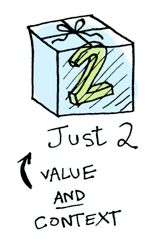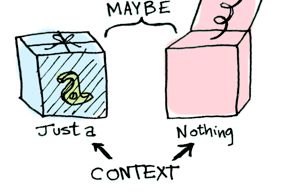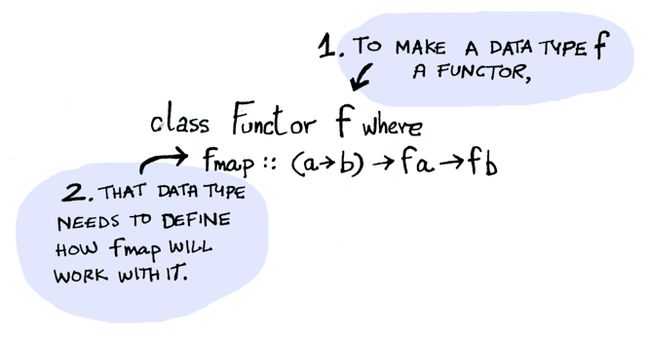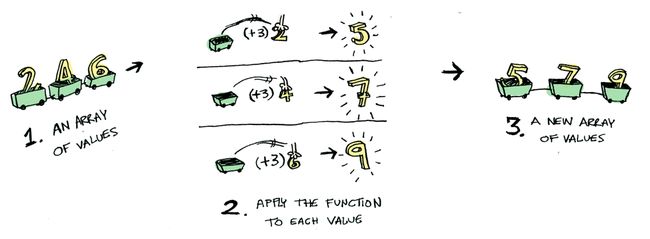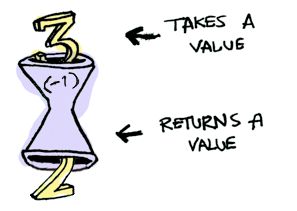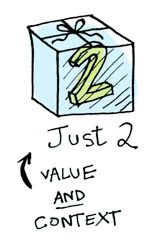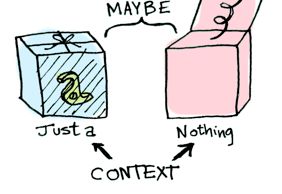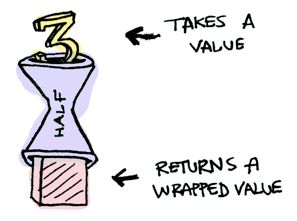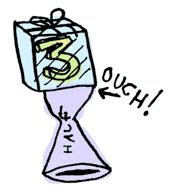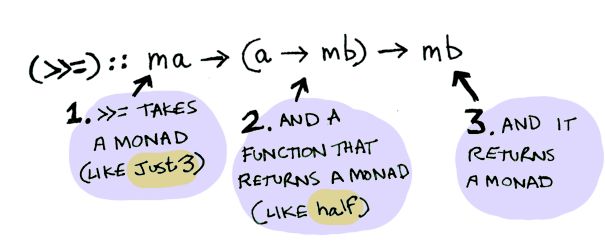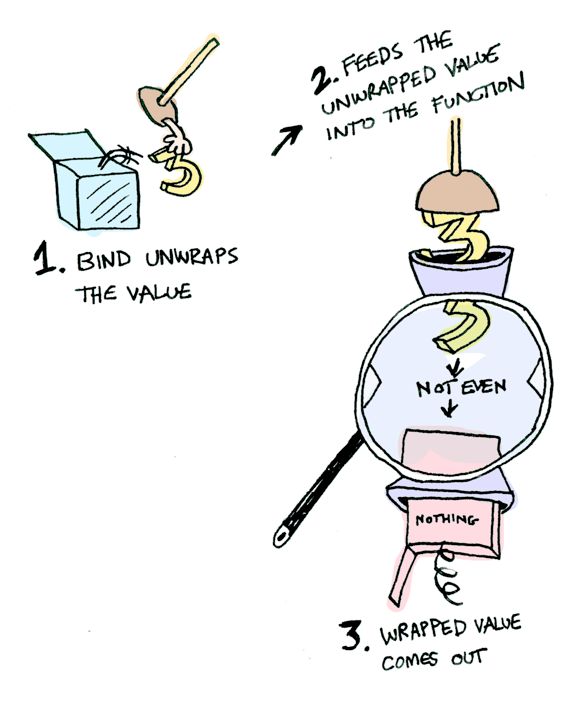Functors, Applicatives, And Monads In Pictures
Functors, Applicatives, And Monads In Pictures
原文:
http://adit.io/posts/2013-04-17-functors,_applicatives,_and_monads_in_pictures.html
参考文章:
http://homepages.inf.ed.ac.uk/wadler/papers/marktoberdorf/baastad.pdf
Here's a simple value: And we know how to apply a function to this value:
Simple enough. Lets extend this by saying that any value can be in a context. For now you can think of a context as a box that you can put a value in:
Now when you apply a function to this value, you'll get different results depending on the context. This is the idea that Functors, Applicatives, Monads, Arrows etc are all based on. The Maybe data type defines two related contexts:
data Maybe a = Nothing | Just a
In a second we'll see how function application is different when something is a Just a versus a Nothing. First let's talk about Functors!
Functors
When a value is wrapped in a context, you can't apply a normal function to it:
This is where fmap comes in. fmap is from the street, fmap is hip to contexts. fmap knows how to apply functions to values that are wrapped in a context. For example, suppose you want to apply (+3) to Just 2. Use fmap:
> fmap (+3) (Just 2)
Just 5
Bam! fmap shows us how it's done! But how does fmap know how to apply the function?
Just what is a Functor, really?
Functor is a typeclass. Here's the definition:
A Functor is any data type that defines how fmap applies to it. Here's how fmap works:
So we can do this:
> fmap (+3) (Just 2)
Just 5
And fmap magically applies this function, because Maybe is a Functor. It specifies how fmapapplies to Justs and Nothings:
instance Functor Maybe where
fmap func (Just val) = Just (func val)
fmap func Nothing = Nothing
Here's what is happening behind the scenes when we write fmap (+3) (Just 2):
So then you're like, alright fmap, please apply (+3) to a Nothing?
> fmap (+3) Nothing
Nothing
Like Morpheus in the Matrix, fmap knows just what to do; you start with Nothing, and you end up with Nothing! fmap is zen. Now it makes sense why the Maybe data type exists. For example, here's how you work with a database record in a language without Maybe:
post = Post.find_by_id(1)
if post
return post.title
else
return nil
end
But in Haskell:
fmap (getPostTitle) (findPost 1)
If findPost returns a post, we will get the title with getPostTitle. If it returns Nothing, we will return Nothing! Pretty neat, huh? <$> is the infix version of fmap, so you will often see this instead:
getPostTitle <$> (findPost 1)
Here's another example: what happens when you apply a function to a list?
Lists are functors too! Here's the definition:
instance Functor [] where
fmap = map
Okay, okay, one last example: what happens when you apply a function to another function?
fmap (+3) (+1)
Here's a function:
Here's a function applied to another function:
The result is just another function!
> import Control.Applicative
> let foo = fmap (+3) (+2)
> foo 10
15
So functions are Functors too!
instance Functor ((->) r) where
fmap f g = f . g
When you use fmap on a function, you're just doing function composition!
Applicatives
Applicatives take it to the next level. With an applicative, our values are wrapped in a context, just like Functors:
But our functions are wrapped in a context too!
Yeah. Let that sink in. Applicatives don't kid around. Control.Applicative defines <*>, which knows how to apply a function wrapped in a context to a value wrapped in a context:
i.e:
Just (+3) <*> Just 2 == Just 5
Using <*> can lead to some interesting situations. For example:
> [(*2), (+3)] <*> [1, 2, 3]
[2, 4, 6, 4, 5, 6]
Here's something you can do with Applicatives that you can't do with Functors. How do you apply a function that takes two arguments to two wrapped values?
> (+) <$> (Just 5)
Just (+5)
> Just (+5) <$> (Just 4)
ERROR ??? WHAT DOES THIS EVEN MEAN WHY IS THE FUNCTION WRAPPED IN A JUST
Applicatives:
> (+) <$> (Just 5)
Just (+5)
> Just (+5) <*> (Just 3)
Just 8
Applicative pushes Functor aside. "Big boys can use functions with any number of arguments," it says. "Armed <$> and <*>, I can take any function that expects any number of unwrapped values. Then I pass it all wrapped values, and I get a wrapped value out! AHAHAHAHAH!"
> (*) <$> Just 5 <*> Just 3
Just 15
And hey! There's a function called liftA2 that does the same thing:
> liftA2 (*) (Just 5) (Just 3)
Just 15
Monads
How to learn about Monads:
- Get a PhD in computer science.
- Throw it away because you don't need it for this section!
Monads add a new twist.
Functors apply a function to a wrapped value:
Applicatives apply a wrapped function to a wrapped value:
Monads apply a function that returns a wrapped value to a wrapped value. Monads have a function >>= (pronounced "bind") to do this.
Let's see an example. Good ol' Maybe is a monad:
Suppose half is a function that only works on even numbers:
half x = if even x
then Just (x `div` 2)
else Nothing
What if we feed it a wrapped value?
We need to use >>= to shove our wrapped value into the function. Here's a photo of >>=:
Here's how it works:
> Just 3 >>= half
Nothing
> Just 4 >>= half
Just 2
> Nothing >>= half
Nothing
What's happening inside? Monad is another typeclass. Here's a partial definition:
class Monad m where
(>>=) :: m a -> (a -> m b) -> m b
Where >>= is:
So Maybe is a Monad:
instance Monad Maybe where
Nothing >>= func = Nothing
Just val >>= func = func val
Here it is in action with a Just 3!
And if you pass in a Nothing it's even simpler:
You can also chain these calls:
> Just 20 >>= half >>= half >>= half
Nothing
Cool stuff! So now we know that Maybe is a Functor, an Applicative, and a Monad.
Now let's mosey on over to another example: the IO monad:
Specifically three functions. getLine takes no arguments and gets user input:
getLine :: IO String
readFile takes a string (a filename) and returns that file's contents:
readFile :: FilePath -> IO String
putStrLn takes a string and prints it:
putStrLn :: String -> IO ()
All three functions take a regular value (or no value) and return a wrapped value. We can chain all of these using >>=!
getLine >>= readFile >>= putStrLn
Aw yeah! Front row seats to the monad show!
Haskell also provides us with some syntactical sugar for monads, called do notation:
foo = do
filename <- getLine
contents <- readFile filename
putStrLn contents
Conclusion
- A functor is a data type that implements the
Functortypeclass. - An applicative is a data type that implements the
Applicativetypeclass. - A monad is a data type that implements the
Monadtypeclass. - A
Maybeimplements all three, so it is a functor, an applicative, and a monad.
What is the difference between the three?
- functors: you apply a function to a wrapped value using
fmapor<$> - applicatives: you apply a wrapped function to a wrapped value using
<*>orliftA - monads: you apply a function that returns a wrapped value, to a wrapped value using
>>=orliftM
So, dear friend (I think we are friends by this point), I think we both agree that monads are easy and a SMART IDEA(tm). Now that you've wet your whistle on this guide, why not pull a Mel Gibson and grab the whole bottle. Check out LYAH's section on Monads. There's a lot of things I've glossed over because Miran does a great job going in-depth with this stuff.
Translations
This post has been translated into:
Human languages:
- Chinese
- Another Chinese translation
- Chinese, Kotlin
- French
- German
- Japanese
- Korean
- Portuguese
- Russian
- Spanish
- Turkish
- Vietnamese
Programming languages:
- Javascript
- Python
- Swift
- Kotlin. This author also translated this Kotlin version into Chinese.
- Kotlin (translated from the Swift translation)
- Elm
If you translate this post, send me an email and I'll add it to this list!
For more monads and pictures, check out three useful monads.
FP , 又称为 Monadic Programming , 泛函编程。
不同类型的Monad实例则会支持不同的程序运算行为,如:Option Monad在运算中如果遇到None值则会中途退出;State Monad会确保状态值会伴随着程序运行流程直到终结;List Monad运算可能会产生多个结果等等。Scalaz提供了很多不同种类的Monad如:StateMonad, IOMonad, ReaderMonad, WriterMonad,MonadTransformer等等。


